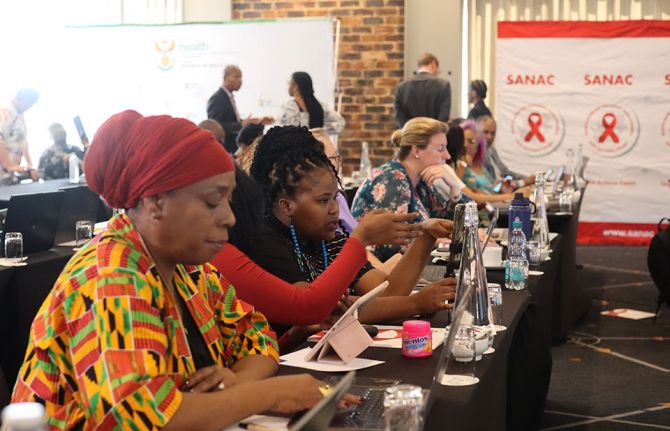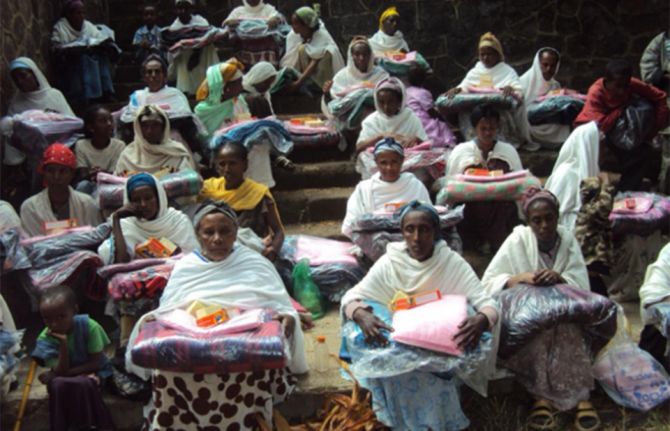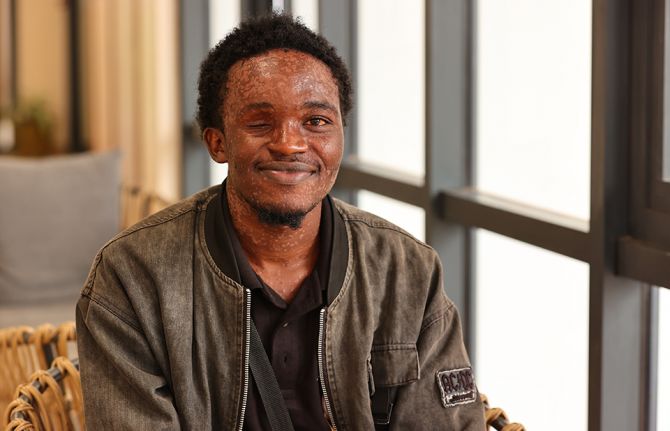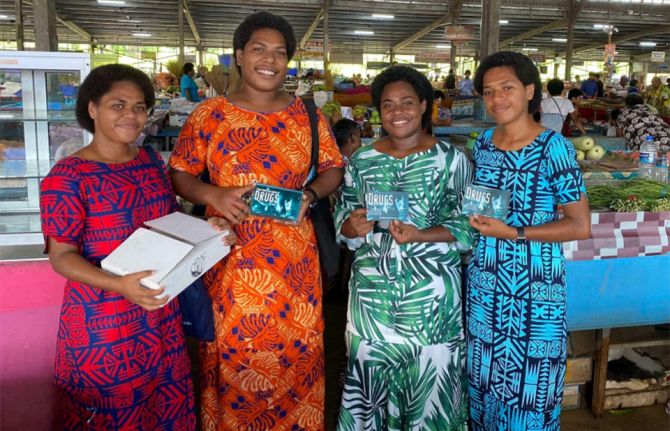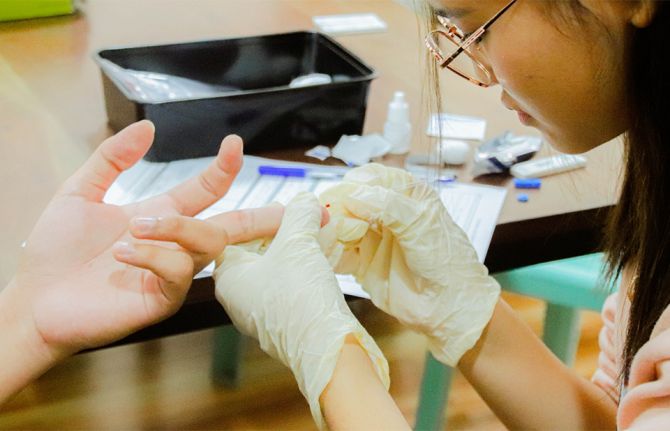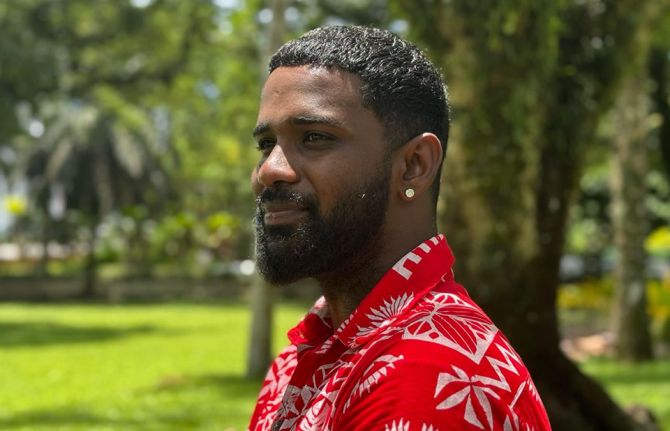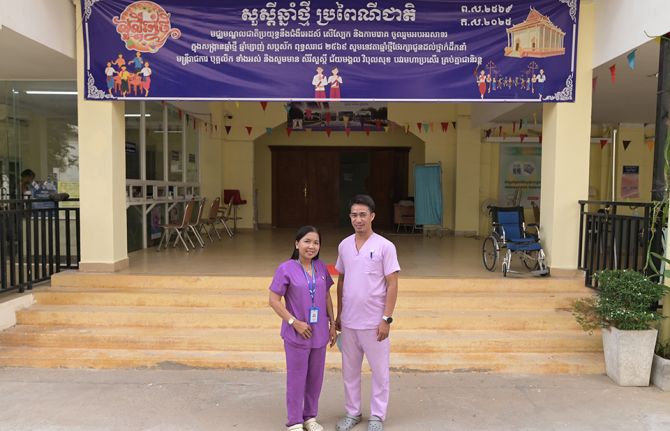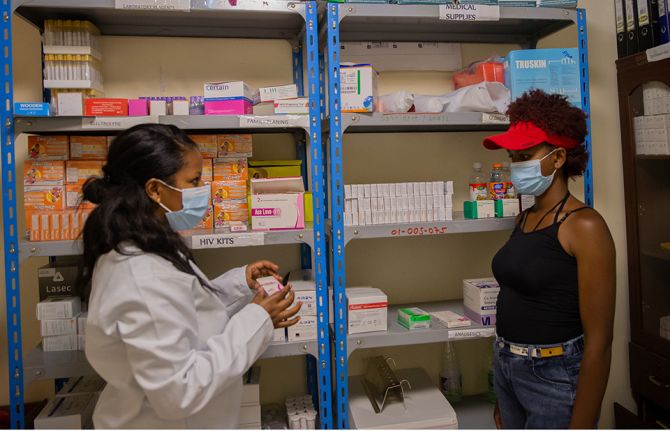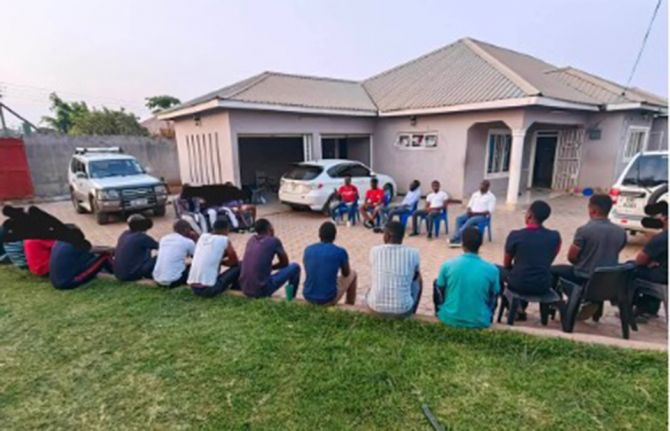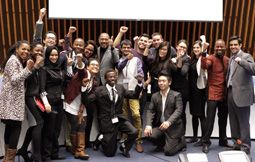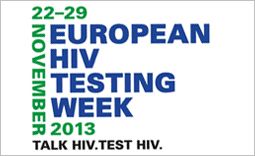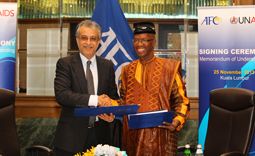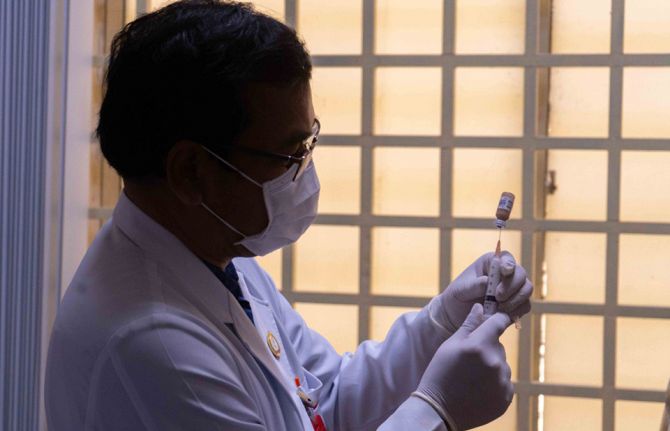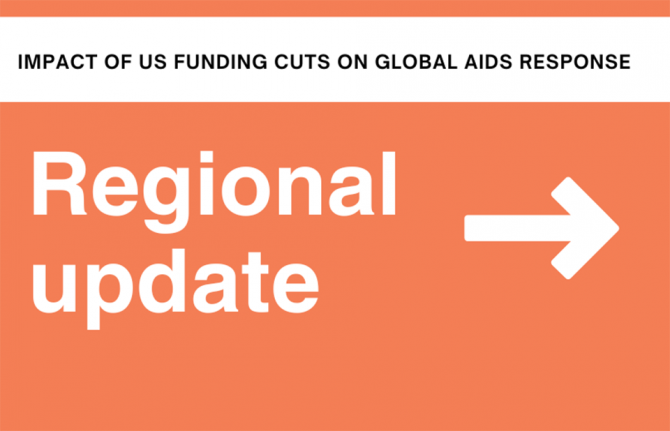
Feature Story
UNAIDS, Millennium Villages join forces to keep children free from HIV in Africa
21 September 2009
21 September 2009 21 September 2009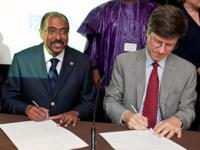
UNAIDS Executive Director Michel Sidibé and Prof. Jeffrey Sachs, Director of the Earth Institute, signing the agreement. 21st September, New York.
Credit: UNAIDS/B.Hamilton
UNAIDS and the Millennium Villages Project signed an agreement in New York to strengthen efforts to eliminate mother-to-child transmission of HIV in Africa. The aim of the partnership is to help local governments create “Mother to child transmission-free zones” in 14 ‘Millennium Villages’ across ten African countries.
The Millennium Villages Project, a partnership between The Earth Institute at Columbia University, Millennium Promise, and UNDP, seeks to end poverty by working in rural areas throughout Africa. The new initiative will use the existing infrastructure, human capacity and technical resources in the villages, to help rapidly expand family- and community-centered heath services with focus on stopping new HIV infections among children.
UNAIDS Executive Director Michel Sidibé and Prof. Jeffrey Sachs, Director of the Earth Institute, signed the agreement in the presence of business and African leaders. The ceremony was held under the auspices of President Yoweri Museveni of Uganda and President Abdoulaye Wade of Senegal.
“I salute this partnership to help protect mothers and their children from HIV. This initiative will mobilize resources and generate political will to save young lives, leading to a generation of African children born free of HIV,” said President Wade.
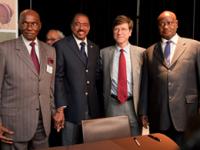
(L to R): President Abdoulaye Wade of Senegal, UNAIDS Executive Director Michel Sidibé, Prof. Jeffrey Sachs, Director of the Earth Institute and President Yoweri Museveni of Uganda.
Credit: UNAIDS/B.Hamilton
Also speaking at the ceremony were Dr Lydia Mungherera, a Ugandan HIV prevention activist representing the organizations HIV+ and TASO. The Executive Director of UNICEF, Ms Ann M. Veneman, the Minister of State of Mali, Mr. Abou Sow; the South African Minister of Health Dr. Aaron Motsoaledi; and Ambassador Eric Goosby, MD, the United States Global AIDS Coordinator participated in a panel discussion at the event.
Each day 1,200 children under the age of 15 are infected with HIV; 90% of these infections occur in sub-Saharan Africa. According to Mr. Sidibe, “In all of Western Europe there were fewer than 100 mother-to-child transmissions (MTCT) in 2007, whereas in sub-Saharan Africa, there were more than 370,000.”
The top priorities outlined in the memorandum include measures to ensure that women of child bearing age avoid getting infected, those that are infected avoid unwanted pregnancy; increase access to antenatal care services; HIV testing and counselling to expectant mothers; and expanded access to HIV prevention and treatment services for children.
The agreement will bring together the Millennium Village Project’s multi-sectoral and science-based development and primary healthcare strategy with UNAIDS’ expertise in community and family-centred prevention strategies in order to create ‘MTCT-free zones’, whose progress will be monitored by both entities.

Executive Director of UNICEF, Ms Ann M. Veneman, South African Minister of Health, Dr. Aaron Motsoaledi, and UNAIDS Executive Director Michel Sidibé.
Credit: UNAIDS/B.Hamilton
“We hope that the creation of ‘MTCT-free zones’ in the Millennium Villages will serve as a model that can be used throughout Africa whereby communities are engaged, men and young people are active partners, and children are born free from HIV,” Mr Sidibé said.
In 2007, there were 2 million children under 15 years living with HIV, up from 1.6 million in 2001 and less than 15% in need of treatment were getting it. In sub-Saharan Africa, only a third of pregnant HIV-positive women received the antiretroviral treatment (ART) to prevent transmitting the infection to their infants, compared with nearly 100% in Western Europe.
Operating in 14 sites in 10 sub-Saharan African countries, the Millennium Villages project has been working with local governments to introduce a model primary health system which will cover approximately 500,000 people.
The Villages work on a model primary health system and include education, nutrition and economic development. The primary health systems include; free services at the point of care; trained professional community health workers; a network of adequately staffed primary clinics; access to a mobile communication network and emergency transport services to facilitate referrals; and a local referral hospital to support second-tier care. The system houses a monitoring and evaluation platform that can readily assess the adequacy, uptake and impact of HIV testing and counselling and family centered HIV prevention services.
UNAIDS, Millennium Villages join forces to keep c
Cosponsors:
Partners:
Feature stories:
Deputy President of South Africa echoes UNAIDS priorities at international AIDS conference (20 july 2009)
Lesotho: HIV free babies bring hope (16 July 2009)
Press centre:
UNAIDS calls for a virtual elimination of mother to child transmission of HIV by 2015 (21 May 2009)
Development leaders point to significant progress in mother and child health and reduction of malaria and AIDS deaths in poorest nations (23 September 2008)
Publications:
Prevention of HIV Transmission from Mother to Child (pdf, 222 Kb.)

Feature Story
United for UNICEF: Manchester United visit highlights HIV and rights of vulnerable children
27 August 2009
27 August 2009 27 August 2009A version of this story was first published at UNICEF.org
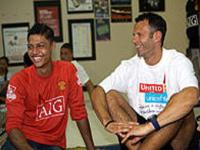
UNICEF UK Ambassador and Manchester United player Ryan Giggs enjoys a lively conversation with a refugee teen whose parents come from Myanmar and who spends his free time as a football coach for younger refugee children in Malaysia.
Credit: UNICEF Malaysia
Manchester United stars Ryan Giggs, Patrice Evra and Federico Macheda, along with Manchester United Foundation Chief Executive John Shiels, took time out of the club's pre-season tour of Asia in mid-July to help UNICEF champion the rights of vulnerable children and those affected by HIV in Malaysia.
The football stars visited Positive Living, a programme operated by the community-based PT Foundation. The group spent time with 10 young people from various challenging backgrounds – including children from families affected by HIV, and children whose parents are sex workers or drug users, as well as street children and young refugees.
Despite Malaysia’s progress in child health and education, many children still find themselves living on the margins of society as a result of discrimination, stigma and prejudice. These marginalized children are in the highest-risk category for HIV infection.
Stark realities for children
By joining these children here today and showing our support, we hope to send out a powerful message – that all children, no matter their background, where they live or their HIV status, should be treated equally.
Ryan Giggs, Manchester United footballer
Joined by the players for an intimate discussion, the young people at Positive Living shared their feelings, dreams and daily experiences, revealing the stark realities of life for youths shadowed by HIV, drug abuse, violence, exploitation and displacement.
Mr. Giggs spoke with Asha (not her real name), 15, whose father died as a result of AIDS-related illness. Asha recalled the day her mother revealed her own HIV status.
“When my mother told me that she was HIV-positive, I panicked and didn’t know what to do,” she said. “I could not accept it.”
After her father died, Asha and her mother were forced to move from their home and community due to AIDS stigma and discrimination. “After my father passed away everyone hated my mother. Everyone hurt her,” she said.
Fair and equal treatment
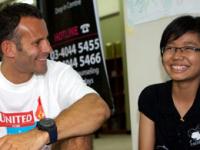
Credit: UNICEF Malaysia
Through their visit, the Manchester United players aim to highlight the facts about HIV, help break down the prejudice and stigma faced by marginalized children; and advocate for their right to be treated fairly.
“It’s tragic to hear how marginalized children and those affected by HIV suffer as result of stigma,” said Mr. Giggs. “But by joining these children here today and showing our support, we hope to send out a powerful message – that all children, no matter their background, where they live or their HIV status, should be treated equally.”
UNICEF is working with the government and partners to challenge discrimination, protect children, reduce stigma and promote awareness of these issues – including HIV prevention in a country where an estimated 80,000 people are living with the virus.
Challenging stigma is vital
“Fighting against stigma is a vital step in protecting marginalized children,” said Mr. Evra. “To do this, we must all learn the facts about HIV: You cannot get HIV by playing with children who are HIV-positive.”
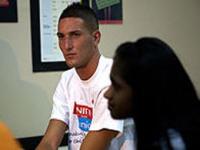 Manchester United player Federico Macheda participates in a sharing session with vulnerable children in Malaysia.
Manchester United player Federico Macheda participates in a sharing session with vulnerable children in Malaysia. Credit: UNICEF Malaysia
The footballers’ visit represents the latest development in the ground-breaking 10-year ‘United for UNICEF’ partnership between Manchester United and UNICEF and highlights the club’s continuing commitment to UNICEF’s 'Unite for Children, Unite against AIDS' global campaign. UNICEF is a cosponsor of UNAIDS.
Since 1999, the partnership has raised over $3.75 million, benefiting over 1.5 million children worldwide. In 2007, the club donated more than $150,000 to UNICEF Malaysia for youth HIV-prevention programmes.
“Lasting solutions for the next generation must address both protection from HIV and protection of children's rights," said UNICEF Representative to Malaysia Youssouf Oomar. "These rights are not merely the benefit of a few but the entitlement of all children, regardless of their identity, HIV status, geographical location or gender."
The ‘United for UNICEF’ 10th anniversary coincides with the 20th anniversary of the Convention on the Rights of the Child this year.
United for UNICEF: Manchester United visit highli
Cosponsors:
Partners:
Unite for Children, Unite against AIDS
United for UNICEF
Positive Living
Feature stories:
Peer educators raising HIV awareness through sport in Trinidad and Tobago (03 June 2009)
UNICEF working to teach AIDS prevention to young people in Guinea (16 April 2009)
UNICEF: Communities provide a bigger ‘family’ for orphaned children in Rwanda (09 March 2009)
Third stocktaking report on children and AIDS (01 December 2008)
Multimedia:
UNICEF photo essay on paediatric HIV in Zambia
Publications:
Children and AIDS: Third stocktaking report, 2008 (pdf, 1.90 Mb.)
Children and AIDS: Third stocktaking report, 2008, Summary (pdf, 2.71 MB.)

Feature Story
More needs to be done to help young people most at risk of HIV infection
10 August 2009
10 August 2009 10 August 2009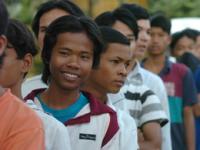
Credit: UNAIDS/O.O'Hanlon
In general, HIV prevention services in the Asia region are currently not reaching young people who are most at risk of infection, which include those who inject drugs, who engage in unprotected male to male sex and those involved in sex work and their clients. In order to address this situation the Asia Pacific Regional UN Coordination Group on Most at Risk Young People hosted a symposium at the IX International Congress on AIDS in Asia and the Pacific.
According to epidemic models presented in the 2008 AIDS in Asia Commission report, over 95% of all new HIV infections in the Asia region occur among such most at risk young populations. However, over 90% of resources for young people as a group are spent on low-risk youth, who represent less than 5% of infections.
Entitled "HIV prevention and most at risk young people", the event was sponsored jointly by UNFPA, UNICEF, UNESCO, UNAIDS, UNDP, WHO and is supported by 7Sisters, the Coalition of Asia Pacific Regional Networks on HIV/AIDS. It examined, among other issues, how the specific needs of most at risk young people should be addressed, what works and what doesn't and how partnerships between youth, NGOs and government can be strengthened.
The symposium discussed the nexus of unsafe sexual behaviours among most at risk young people where a number of such practices coexist in the same environment. Sex work, drug use and unprotected sex with multiple partners can all occur in the same social network. Therefore, participants looked at an approach which addresses a multiplicity of needs, meshing and coordinating previously implemented programmes and ensuring a youth-friendly approach.
A comprehensive, evidence-informed response, it was argued, requires firm commitment from donors and governments to address the specific needs of most at risk young people, and an examination of the contexts in which these risks occur. The engagement of this group in developing the policies, programmes and processes that directly affect and benefit them is seen as a prerequisite. Young people played an active and central role in this event as the practical aspect of exactly how to get youth involved in decision making was explored.
Specific objectives of the meeting also included promoting awareness among policy makers and programme planners on the urgent need for HIV prevention for most at risk young people and encouraging increased collection, analysis and use of data on this key group to support advocacy efforts and inform budget allocation priorities. Sharing experience of programming in this area, both positive and not so positive, was on the agenda too.
Among those taking part in the event were the UNFPA's Deputy Executive Director (Programme), Purnima Mane. UNESCO’s Jan de Lind van Wijngaarden, and UNICEF’s Margaret Sheehan spoke on behalf of the Asia Pacific Regional UN Coordination Group on Most at Risk Young People. James Chau, member of the AIDS2031 initiative, UNAIDS Goodwill Ambassador and Chinese television presenter facilitated the panel discussion. The panel also involved representatives of the medical profession, NGOs, health ministries and representatives of young people involved in sex work, drug use and male to male sex.
More needs to be done to help young people most a
IX International Congress on AIDS in Asia and the Pacific
Cosponsors:
Partners:
7Sisters, the Coalition of Asia Pacific Regional Networks on HIV/AIDS
Feature stories:
International Harm Reduction conference opens in Bangkok (20 April 2009)
OPINION: HIV and drugs: two epidemics - one combined strategy (20 April 2009)
Swing and Sisters: HIV outreach to sex workers in Thailand (19 March 2009)
Injecting drug use and HIV: Interview with UNAIDS Team Leader, Prevention, Care and Support team (11 march 2009)
OPINION: Silence on harm reduction not an option (11 March 2009)
Spotlight: men who have sex with men and HIV (16 February 2009)
Hidden HIV epidemic amongst MSM in Eastern Europe and Central Asia (26 January 2009)
HIV prevention hampered by homophobia (13 January 2009)
Publications:
UNAIDS Action Framework: Universal Access for Men who have Sex with Men and Transgender People (pdf, 323 Kb.)
Framework for monitoring and evaluating prevention programmes for most-at-risk-populations (pdf, 1.49 Mb.)
Policy Brief: HIV and Sex between men (pdf, 277 Kb.)

Feature Story
UNAIDS Cosponsors out in force for 9th ICAAP
09 August 2009
09 August 2009 09 August 2009
The 10 UNAIDS Cosponsors are presenting a strong showing as thousands of delegates converge in Bali, Indonesia, to share ideas, knowledge, best practices, lessons learned and research findings at the 9th International Congress on AIDS in Asia and the Pacific (ICAAP).
The Cosponsors are an integral part of the UN’s response to the global AIDS epidemic and UNAIDS brings together their efforts and resources.
Echoing the Congress theme, ‘Empowering people - strengthening networks’, the Cosponsors are organising and presenting symposia, skills-building workshops and satellite meetings drawing together a number of participants from a range of disciplines with the aim of helping to build and nurture partnerships to bolster the AIDS response in the region.
A number of events are joint Cosponsor initiatives. For example, the Symposium on ‘HIV prevention and most at risk young people’, taking place on 10 August, is sponsored by UNFPA, UNICEF, UNESCO, UNDP, WHO and UNAIDS. The symposium, hosted by the Asia Pacific Regional UN Coordination Group on Most at Risk Young People, is designed to look at the specific needs of this population which is, in general, not being reached by HIV prevention services. This includes injecting drug users, men who have sex with men and sex workers and their clients. Representatives from these groups will also take part in the panel discussion –one further example of how Cosponsor ICAAP activities are designed to involve key populations.
Other examples of Cosponsor activities include UNDP, ILO and UNAIDS (with the Joint United Nations Initiative on Mobility and HIV/AIDS in South East Asia) collaborating on a joint symposium on 12 August entitled, ‘The Impact of the Financial Crisis on Labour Migration and HIV’ in which they will bring their respective expertise to bear on this pressing international issue. UNHCR, along with UNAIDS, is hosting a satellite session on 12 August called ‘Opportunities and challenges in addressing HIV amongst diverse humanitarian populations’. WFP will use a satellite session on 11 August to explore the vital role of nutrition and food security for people living with HIV and will, along with its partners, look at ‘Models for integrating nutrition and food security into HIV care, support and treatment in the Asia Region: Opportunities and challenges’.
The World Bank is also championing the screening, on 10 August, of the film, Suee (Needle) by Cannes Film Festival award winner, Sai Paranjpye, which deals with the lives of injecting drug users and the anti-AIDS stigma they face. The film emerged from the South Asia Region Development Marketplace, a grant programme spearheaded by the Bank and supported by a range of partners including UNAIDS, UNICEF, UNODC and UNDP.
There is an extremely broad range of other Cosponsor activities taking place over the five days of the Congress and a number of these events will be highlighted on the UNAIDS website as the ICAAP progresses.
UNAIDS and its ten Cosponsors work to provide technical support to countries to assist them in the implementation of their national AIDS plans. A ‘division of labour’ guides the technical support provided to enhance coordination, avoid duplication and provide the best assistance available. Each of the Cosponsor organizations leads in at least one technical area. These organizations are:
Office of the United Nations High Commissioner for Refugees (UNHCR)
United Nations Children's Fund (UNICEF)
United Nations Development Programme (UNDP)
United Nations Population Fund (UNFPA)
United Nations Office on Drugs and Crime (UNODC)
International Labour Organization (ILO)
United Nations Educational, Scientific and Cultural Organization (UNESCO)

Feature Story
HIV Treatment data update – July 2009
23 July 2009
23 July 2009 23 July 2009An estimated 4 million people in low- and middle-income countries were receiving antiretroviral therapy (ART) at the end of 2008, compared to 3 million in 2007 and 400,000 in 2003, according to preliminary data compiled by WHO, UNAIDS and UNICEF. Approximately 285,000 children benefited from paediatric ART programmes in 2008, a 45% increase over the prior year. In sub-Saharah Africa, nearly 3 million people were accessing treatment in 2008, a 38% increase over 2007.
These and other figures—presented at the International AIDS Society conference in Cape Town—are based on an analysis of data collected from 127 low- and middle-income countries. In collaboration with countries, WHO, UNAIDS and UNICEF are still completing the analysis. Final figures on ART access will be published in the September 2009 "Towards Universal Access" progress report, together with an in-depth analysis of a broad range of health sector HIV/AIDS interventions.
Substantial progress has been made in increasing access to treatment in low and middle income countries. Some countries have already achieved their universal access goals for treatment. However in other countries, the rate of scale up is not sufficient to achieve their national targets for 2010.
Some of the factors hindering progress include weak and fragmented health systems that are not sufficiently decentralized, poor integration of health services, poor access to HIV testing and counselling services, pervasive stigma and discrimination. These constraints are further affected by the recent economic crisis. WHO, UNICEF and UNAIDS together with partners and implementers, are working on responses for countries to overcome the obstacles.
"Towards Universal Access" is an annual report that monitors the health sector response to HIV/AIDS. To access the 2008 report, please visit the following link.
HIV Treatment data update – July 2009
Related

Feature Story
Early diagnosis and treatment save babies from AIDS-related death
27 May 2009
27 May 2009 27 May 2009A version of this story first appeared at unicef.org
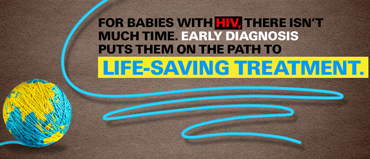
‘Loud and Clear’, the Unite for Children, Unite against AIDS video, shows how early infant diagnosis of HIV can save lives
Many infants across the world are dying needlessly because they are not being tested early enough for HIV and treated if they have the virus. Without treatment, half of all HIV-positive babies will not live long enough to see their second birthday; a third will not see their first.
To help address this situation, the Unite for Children, Unite against AIDS campaign has launched a new video vividly highlighting the importance of early testing and treatment to save the lives of infants who have HIV.
As the video, known as ‘Loud and Clear’, shows infants who are diagnosed and treated early have a far higher chance of survival than those who go untested and untreated. Research demonstrates that if newborns are tested at the age of six weeks and on treatment by 12 weeks there can be a dramatic 75% reduction in infant mortality due to AIDS.
However, according to a report published last year by UNICEF, UNAIDS and WHO, in 2007 only 8% of children born to HIV-positive mothers were tested before they were two months old. Mothers can also help prevent HIV transmission – and protect their own health – by being tested and treated themselves during pregnancy.
Access to care and treatment
Since the launch of the Unite for Children, Unite against AIDS global campaign in 2005, there has been significant progress in scaling up prevention of mother-to-child transmission of HIV – and in the provision of paediatric treatment for babies born with the virus.
In 2007, a third of HIV-positive pregnant women received antiretroviral drugs, or ARVs, to prevent transmission to their children, compared with only 10 per cent in 2004.
Still, far too few pregnant women in the developing world know their HIV status, and too few are tested and treated: both are essential for mother and child. However, most pregnant women who have been diagnosed with HIV do not have access to essential care and treatment, including ARV therapy.
“Mothers should be able to access the tests and drugs necessary to ensure they can protect their babies and themselves,” said UNICEF Senior Advisor on HIV and AIDS, Dr Doreen Mulenga. “Antiretroviral drugs can substantially reduce the risk of a baby getting the HIV virus from his mother.”
Children at risk
Children bear a heavy burden of the virus. UNAIDS and WHO estimates show that in 2007 alone some 370,000 young people under the age of 15 were newly infected, that’s around 1,000 a day; and 270,000 died, the majority under the age of 5. In the same year, fewer than 200,000 young people living with HIV received antiretroviral treatment. Further, those on ARVs often receive it too late for optimal benefits to be gained: recent studies report that the median age at which children begin such treatment is between five and nine years old.
Great strides in Zambia
In Lusaka, the capital of Zambia, the Chelstone Clinic provides vital programmes to treat pregnant women living with HIV and to prevent mother-to-child transmission. The country has made great strides in expanding such programmes, which include HIV testing during pregnancy, ARV regimens for HIV-positive pregnant women, prophylactic antibiotics and ARVs for infants exposed to HIV in utero, and early infant diagnosis and treatment.

Maureen Sakala, who was diagnosed with HIV while pregnant, practices preparing prophylactic antiretroviral medicine for her newborn son, Christopher, held by midwife Grace Kayumba at the Chelstone Clinic in Lusaka, Zambia.
Credit: UNICEF/NYHQ2009-0307/Nesbitt
Christopher was recently born at the clinic. His mother, Maureen Sakala, lives with her mother, siblings and 12 orphaned children – including the children of her brother, who died of AIDS-related illness.
Ms Sakala learned that she was HIV-positive during an antenatal check-up. She participates in the prevention programme at the clinic, where she learned to administer ARVs to Christopher for the first seven days after his birth as a prophylactic measure against HIV infection. His chances of survival are much improved because of Zambia’s success in strengthening maternal, newborn and child health services.
Preventing mothers from dying and babies from becoming infected with HIV has been identified as one of the eight priority areas UNAIDS and its Cosponsors will focus on for the period 2009–2011 under the Joint action for results: UNAIDS outcome framework, 2009 – 2011.
By providing greater access to HIV testing and treatment, partners around the world are working to protect babies like Christopher, and their mothers, from the devastating impact of AIDS.
Early diagnosis and treatment save babies from AI
Cosponsors:
Partners:
Unite for Children, Unite against AIDS
Feature stories:
Early infant HIV diagnosis helps save lives in Malawi (01 December 2008)
UNICEF: Communities provide a bigger ‘family’ for orphaned children in Rwanda (09 March 2009)
Third stocktaking report on children and AIDS (01 December 2008)
Multimedia:
'Loud and Clear' video: How early infant diagnosis of HIV can save lives
Photo essay on paediatric HIV in Zambia
PSA: Claudia Schiffer, UNICEF UK Ambassador on early infant diagnosis
Publications:
Joint action for results: UNAIDS outcome framework, 2009 – 2011 (pdf, 432 Kb.)
Unite for Children, Unite against AIDS Briefing Paper: Scaling up early infant diagnosis and linkages to care and treatment January 2009 (pdf, 923 Kb.)
Children and AIDS: Third stocktaking report, 2008 (pdf, 1.90 Mb.)
Children and AIDS: Third stocktaking report, 2008, Summary (pdf, 2.70 Mb.)

Feature Story
Joint action for results: UNAIDS outcome framework, 2009 – 2011
22 April 2009
22 April 2009 22 April 2009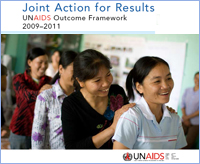
The HIV organizational landscape has evolved and grown more complex over the past decade. UNAIDS, donors and civil society, including networks of people living with HIV, have rightly demanded greater clarity on the relationships between needs, financing, activities and outcomes. Also demanded is greater specificity about the role of UNAIDS and the Secretariat within the wider constellation of actors.
This Outcome Framework, which builds upon the UNAIDS Strategic Framework (2007–2011), will guide future investment and hold the Secretariat and the Cosponsors accountable for making the resources of the UN work for results in countries. It affirms the UNAIDS Secretariat and Cosponsors to leverage our respective organizational mandates and resources to work collectively to deliver results.
Joint action for results: UNAIDS outcome framework, 2009 – 2011 (pdf, 388 Kb)
Joint action for results: UNAIDS outcome framewor
Cosponsors:
Office of the United Nations High Commissioner for Refugees (UNHCR)
United Nations Children's Fund (UNICEF)
World Food Programme (WFP)
United Nations Development Programme (UNDP)
United Nations Population Fund (UNFPA)
United Nations Office on Drugs and Crime (UNODC)
International Labour Organization (ILO)
United Nations Educational, Scientific and Cultural Organization (UNESCO)
World Health Organization (WHO)
World Bank
Publications:
Joint action for results: UNAIDS outcome framework, 2009 – 2011 (pdf, 388 Kb)
Related

Feature Story
UNICEF working to teach AIDS prevention to young people in Guinea
16 April 2009
16 April 2009 16 April 2009A version of this story was first published on UNICEF.org
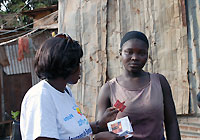
Fatoumata in a salon in a poor Koloma neighbourhood of Conakry. She is 18, has two children, aged six and three, and has never heard of AIDS. Credit: UNICEF Guinea/2009/Baro
Nene Gallé Barry sells charcoal in a very poor area of the Koloma quarter in Conakry, Guinea’s capital. She is 18 now, but left her home village four years ago to earn a living in the city. She has a boyfriend and is sexually active and, until recently, she had never heard of AIDS and had never seen or used a condom.
This is the reality for many adolescents in Guinea. Adolescents often lack access to information that will protect them from sexually transmitted infections (STIs), including HIV. According to a recent UNAIDS/WHO/UNICEF report, in 2007 only 12% of females aged 15 to 24 had correct knowledge of, and rejected myths about, sexual transmission of the virus. In addition, just under a quarter of adolescents aged 15 to 17 used condoms during sexual intercourse, according to a 2005 study.
When Nene finally learned about the risks she had been taking by not using protection, she asked for condoms. She wanted to know how to use them and how to convince her partner to wear them and was very pleased when she’d learned what to do.
Improving youth access to information
In Guinea girls are particularly at risk of contracting STIs. According to the UNAIDS/WHO/UNICEF 2008 report, 31% of girls have had sexual intercourse before the age of 15. (For boys, the figure is 20%). The publication also confirms that girls and women in the 15 to 24 age group are twice more likely to be infected with HIV than their male counterparts.
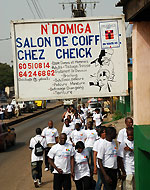
A group of peer educators enter
a hair salon in Miniere, Conakry.
Credit: UNICEF
Guinea/2009/Baro
A high number of young women are involved in jobs that expose them to unsafe sexual practices; jobs such as selling fruit on the streets or working in hair and sewing salons. In these settings they often meet male adolescents or older men who offer money in exchange for sex.
UNICEF and its national partners have taken major steps to improve youth access to information and informed decision making concerning HIV. The first national prevention strategy for youth was produced in 2007, and a coordinating team has been set up in order to coordinate and scale up activities. For the past two years UNICEF has partnered with JCI (Junior Chamber International) to empower adolescents within poor communities and involve them in projects that reach other vulnerable adolescents, mostly girls.
'My job, my health'
From 2007 to 2008 the programme reached more than 20,000 adolescents ranging in age from 13 to 20, all from different backgrounds. Eight TV spots in four different languages were produced, as well as 20 interactive radio shows.
The newest project is called 'mon MÉtier, ma santé' ('my job, my health'), and aims to reach girls working in hair dressing and tailoring shops in two of the poorest neighbourhoods in Conakry. One hundred peer educators are planning to visit the selected sites and help educate young apprentices and clients about HIV prevention.
It is hoped that once the young girls have received the information about HIV prevention will then reach out to their family members and friends. A study will be conducted after two months of such sensitization activities to evaluate the impact of the project. UNICEF hopes to be able to reach at least 50 per cent of the most vulnerable girls by 2011.
Right Hand Content
Key populations:
Young people
Women and girls
Condoms
HIV prevention
Cosponsors:
Partners:
Junior Chamber International (JCI)
Feature stories:
Barber Shops and Beauty Salons promote HIV education in Guyana (26 March 2009)
Condoms and HIV prevention: Position statement by UNAIDS, UNFPA and WHO (19 March 2009)
Costa Rica: Peer HIV prevention programmes to be promoted for young people (03 March 2009)
Publications:
Best practice: Making condoms work for HIV prevention (pdf, 1.1 Mb)
UNAIDS action plan on intensifying HIV prevention (pdf, 1.71 Mb)

Feature Story
UNAIDS Committee of Cosponsoring Organizations meet
06 April 2009
06 April 2009 06 April 2009
(from left): Joy Phumaphi, Vice President and Head of the Human Development Network, World Bank; Arnauld Akodjenou, Director, Division of Operational Services, UNHCR; Josette Sheeran, Executive Director, WFP; Anarfi Asamoa-Baah, Deputy Director General, WHO; Assane Diop, Executive Director, Social Protection Sector, ILO; Koichiro Matsuura, Director General, UNESCO; Ad Melkert, Administrator ad-interim, UNDP; Ann M. Veneman, Executive Director, UNICEF; Michel Sidibé, Executive Director, UNAIDS; Thoraya Ahmed Obaid, Executive Director, UNFPA; Antonio Maria Costa, Executive Director, UNODC. Paris, 3 April 2009,
The Joint United Nations Programme on HIV/AIDS (UNAIDS) brings together the efforts and resources of ten UN system organizations in the AIDS response. The UNAIDS Committee of Cosponsoring Organizations (CCO) serves as the forum for these Cosponsors to meet on a regular basis to consider matters of major importance to UNAIDS, and to provide input from the Cosponsoring organizations into the policies and strategies of UNAIDS.
On 3 April 2009, the CCO held their first meeting since the appointment of UNAIDS Executive Director Michel Sidibé.
The CCO expressed their full support for “universal access” which Mr Sidibé has outlined as the top priority for UNAIDS as well as the other priority areas of focus which will be set out in the new UNAIDS outcome framework currently being finalized with Cosponsors.
The meeting provided an excellent opportunity to share ideas on supporting countries in achieving their universal access goals. The need for UNAIDS to advocate for an evidence informed AIDS response that is grounded in human rights was accepted by all. Equally important was the need for accountability and results.
The CCO also endorsed the general directions of the 2010-2011 Unified Budget and Workplan including the key priorities and the allocation of resources between the Cosponsors, the Secretariat and Interagency activities. The Secretariat will now work with the Global Coordinators of the Cosponsors to finalize the UBW for the June 2009 meeting of the Programme Coordinating Board.
UNAIDS Committee of Cosponsoring Organizations (CCO)
The CCO comprises representatives from the ten UNAIDS Cosponsors and the UNAIDS Secretariat. It meets twice a year and each Cosponsor rotates as chair of the committee annually, on 1 July.
Right Hand Side
Cosponsors:
Office of the United Nations High Commissioner for Refugees (UNHCR)
United Nations Children's Fund (UNICEF)
World Food Programme (WFP)
United Nations Development Programme (UNDP)
United Nations Population Fund (UNFPA)
United Nations Office on Drugs and Crime (UNODC)
International Labour Organization (ILO)
United Nations Educational, Scientific and Cultural Organization (UNESCO)
World Health Organization (WHO)
World Bank
Related
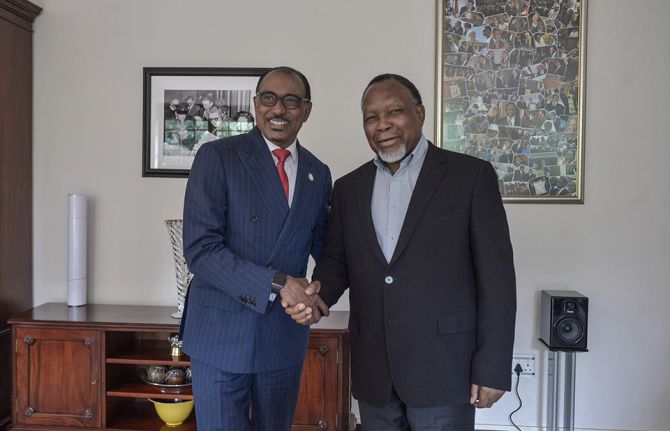 Keeping up the momentum in the global AIDS response
Keeping up the momentum in the global AIDS response

24 April 2019
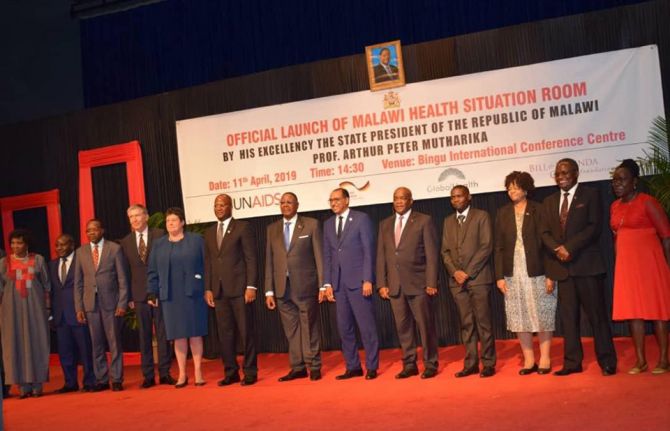 Malawi launches its health situation room
Malawi launches its health situation room

12 April 2019
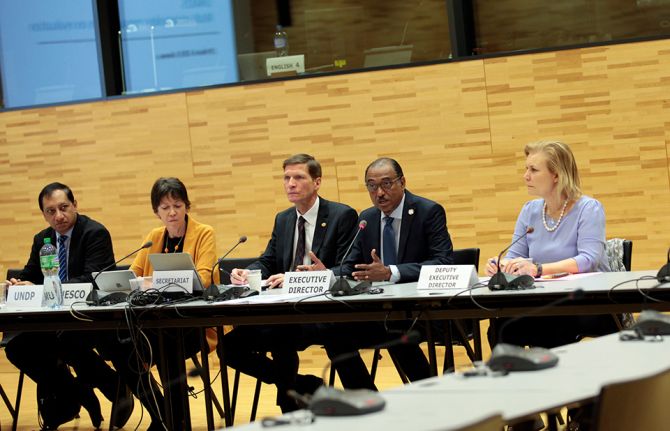 Learning lessons on evaluation
Learning lessons on evaluation

02 April 2019

Feature Story
UNICEF: Communities provide a bigger ‘family’ for orphaned children in Rwanda
09 March 2009
09 March 2009 09 March 2009This story was first published on UNICEF.org

Clementine, 18, and her sister, both HIV-tested and safe in eastern Rwanda.
Credit: UNICEF/2009/Frejd
Bamporeze is a non-governmental organization that started a community-based protection programme for children orphaned by AIDS in Rwanda soon after the genocide in 1995. Around 150,000 people live with HIV in Rwanda; 19,000 of them are children.
Clementine, 18, lives in eastern Rwanda and has been deeply affected by the AIDS epidemic.
“My parents died from an AIDS-related illness a few years ago,” she said, “but no one told us what they had or that we, too, should be tested.”
"My parents died from an AIDS-related illness a few years ago, but no one told us what they had or that we, too, should be tested."
Clementine, 18, lives in eastern Rwanda and has been deeply affected by the AIDS epidemic.
Clementine and her siblings were tested and now have a larger group they can rely on – an extended ‘family’ consisting of members of the community, mobilised by Bamporeze, who found out about Clementine and her siblings after their parents died.
Community support for orphans
While working with orphans, Bamporeze realised that foster families were not sustainable for all the orphans.
“There were just too many orphans,” said Bamporeze founder and coordinator Jeanne D’Arc Muhongayire. “So we decided to see how we could work with the whole community to try to rebuild children’s lives to create a feeling of a common responsibility for orphans.”
To create this larger family, Bamporeze, with support from UNICEF, helped orphaned children continue their education, learn skills and access information on reproductive health and life skills. Children in Clementine’s area also started their own agricultural cooperative to earn income to buy books, medicines and clothes. Bamporeze helped them find mentors who could be like parents to them.
A mentor to serve as parent
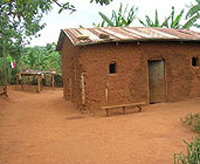
Clementine’s home in Rwanda; both of her parents died of AIDS-related illnesses several years ago.
Credit: UNICEF/2009/Frejd
“When Clementine and her siblings lost their parents, they were initially isolated from the other families,” said Patrick, who works with Bamporeze. “This happens to other children as well, and as their homes are spread out, it is hard to reach all of them to tell them that they are not alone.
“In fact,” Patrick continued, “I spend a lot of my time walking from one children’s household to another to ensure that all are registered with us and have access to the services. I then selected a mentor from the village – a person they trust and think can give them the support they need.”
“Our mentor comes to visit us every day,” said Clementine. “I talk to her about anything and she has introduced me to other children like us. It is good to know that we are not alone.”
Government bears responsibility
Bamporeze’s community-based programme for orphans has succeeded in registering every orphaned child with local authorities.
“This means that local government now also knows about these children and bears responsibility for their well-being,” said the Head of UNICEF Rwanda’s HIV and AIDS Section, Bernardine Mukakizima.
“Bamporeze has helped initiate a programme that serves as an example to other communities in this country,” she added. “We don’t have to wait for foster families or adoptions or even rely on them, if a community is mobilised and feels a sense of ownership for ‘its’ children, then orphaned children around this country will know that they are not alone.”
UNICEF: Communities provide a bigger ‘family’ for orphaned children in Rwanda
Cosponsors:
Feature stories:
Home Truths: Facing the facts on children, AIDS, and poverty (19 February 2009)
Revival of old traditions brings hope to orphans in Swaziland (30 August 2006)

